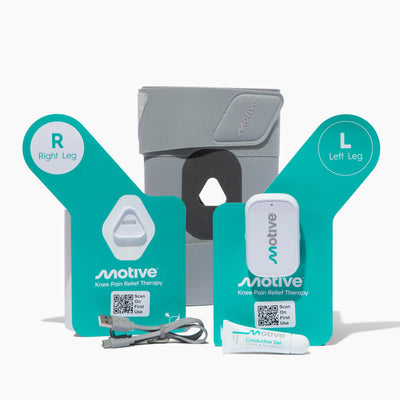
Knee pain is one of the most common musculoskeletal conditions, affecting millions of people worldwide, whether you’ve had surgery, a sports injury, or a chronic condition like osteoarthritis.
This discomfort can keep you from daily activities, impacting mobility and overall quality of life. Proper pain management and physical therapy are key to recovery, pain relief, improved joint function, and long-term mobility.
You must manage your knee pain effectively to regain strength and prevent future injuries or complications. Whether you’ve had an anterior cruciate ligament (ACL) tear, knee osteoarthritis, or overuse injuries, knowing the proper treatment options is key to living an active, pain-free life.
In this article, Jessica Paparella-Wachtel, DPT provides guidance on the most common causes of knee pain, physical therapy, and how innovative solutions like Motive can help your healing journey.
The Role of Physical Therapy in Knee Pain Management
Physical therapy plays a big role in managing and recovering from knee pain, with a patient-specific approach to treatment. Whether you have rheumatoid arthritis, collateral ligament injuries, sprains from chronic overuse, or inflammation from patellar bursitis, physical therapists work with you to design a plan of care to relieve knee problems, restore function, and improve mobility.
During a physical exam, a physical therapist will assess your knee pain by conducting clinical tests to confirm the diagnosis and identify underlying issues. This might involve taking an X-ray and consulting with your orthopedic surgeon if necessary.
This full lower extremity assessment often includes looking at the following:
- muscle imbalances
- flexibility deficits
- range of motion limitations
- movement abnormalities
Physical therapists can then create a plan to address specific weaknesses and functional deficits by reviewing these factors.
Physical therapy techniques focus on knee joint health by improving range of motion, flexibility, and neuromuscular re-education to ensure proper muscle patterns.
Jessica, a Doctor of Physical Therapy, notes, “During treatment of knee pain, we look to restore range of motion, lower extremity flexibility, neuromuscular re-education, reinforce proper recruitment patterns, improve lower extremity strength and balance, and functional re-training to attain patient goals and improve quality of life.”
Strengthening exercises, particularly progressive resistive exercises, are integral to this process. Therapists start with bilateral closed-chain exercises and, depending on the patient's progress, progress to unilateral or eccentric exercises.
- Bilateral closed-chain exercises involve coordinated movements of both limbs with a fixed distal end. Examples include squats, push-ups, and lunges. These exercises improve functional strength, stability, and reduce injury risk.
- Unilateral exercises involve movements that engage one limb at a time. Examples include single-leg squats, dumbbell curls, and single leg knee extensions. These exercises can help identify and correct muscle imbalances, improve balance and coordination, and strengthen specific muscles.
- Eccentric exercises involve lengthening the muscle under tension. Examples include lowering the weight during a bicep curl or descending during a squat. These exercises can help build strength, improve muscle size, and aid in recovery from injuries.
Outside of clinic treatments, physical therapists encourage active participation with at-home exercises so patients can take control of their knee health and continue their recovery independently. This holistic approach reduces pain and improves long-term knee function and life.
If you have a jumper’s knee, you may also be prescribed anti-inflammatory medication, steroid shots, or even platelet-rich plasma injections to help with the pain and better manage tendinitis.
Key Exercises Recommended by Physical Therapists
When it comes to knee arthritis and pain, physical therapists focus on exercises that target the quadriceps and hip muscles to balance out the muscles and joints. Strengthening these muscles can lead to patients becoming less reliant on over-the-counter pain relievers (like ibuprofen, naproxen, and acetaminophen) and other nonsteroidal anti-inflammatory drugs (NSAIDs).
Acupuncture, knee braces, and ice packs only provide short-term relief. Strengthening your quadriceps muscles provides a long-term solution to supporting the knee, reducing stress on the joint and improving overall mobility.
Quadriceps exercises are important for knee health. Strong quadriceps stabilize the kneecap (patella) and take pressure off the knee joint, preventing pain and injury.
Jessica suggests a progressive strengthening approach for your knees, focusing on breaking the pain cycle and activating the quadriceps. Quadriceps activation and strengthening are crucial for achieving terminal knee extension, which is essential for efficient standing and walking. By addressing pain, swelling, and quadriceps weakness, you can improve overall knee function and reduce discomfort.
The following are recommended by physical therapists to strengthen your quad muscles:
- Quadriceps sets are simple isometric exercises that activate the quadriceps muscles without requiring knee movement. To perform a quadriceps set, lie on your back and tighten your quadriceps muscles, as if trying to push your kneecaps into the floor. Hold this contraction for 3-5 seconds, then relax and repeat 15-30 times, multiple times a day.
- Straight leg raises are exercises that activate the quadriceps muscles without bending the knee. To perform a straight leg raise, lie on your back and lift one leg straight up towards the ceiling, holding it for a few seconds before lowering it back down.
- Mini squats or wall sits are closed-chain exercises that build strength and engage the entire lower body. For example, in a wall sit, you lean against a wall with your knees bent at a 90-degree angle, holding the position for as long as possible.
Hip strengthening is just as important as the knee exercises above, as weak hips can cause knee misalignment and increase the risk of injury. Exercises like clamshells, bridges, and lateral leg raises are recommended to balance the muscles around the knee.
One main focus of physical therapy is to achieve proper knee extension. Full extension allows for a more efficient gait (a person’s manner of walking) and prevents overcompensation in the hips and lower back. Techniques to improve knee extension include stretching exercises like hamstring stretches and heel props (using gravity to gently straighten the leg).
Home exercise program participation is key to progress outside of the physical therapy clinic. Doing the exercises above at home strengthens the quadriceps and surrounding muscles for long term knee health and function.
“We encourage patients to complete home and gym programs to assist with knee pain and continue to be actively involved in the future health of the knee.” - Jessica Paparella-Wachtel, DPT
Tools like Motive Knee can easily be added to an at-home recovery routine to get optimal results. By using electrical stimulation, it not only strengthens the quads but also aids in their activation, ensuring complete muscle engagement. This is especially beneficial for those recovering from injuries or looking to improve overall muscle function.
“Home exercise programs for any knee injury should include strengthening of the hip,” Jessica adds. “The hip is also important in the rehabilitation of the knee. Hip flexors, abductors, and glutes play a role in decreasing knee pain and improving function.”
Jessica also reminds patients that strength gains will often be accompanied by soreness but not to be swayed by this. “Soreness is good,” she says. “It means the muscle is being used and getting stronger.” She advises that patients do the following when experiencing different levels of pain during exercises.
Pain levels ranging from 1-10, 10 being the highest level of pain:
- 1-3 pain: keep going with exercises
- 3-5: back off the activity
- >5: STOP the activity
Lifestyle Adjustments and Preventive Measures
By making a few changes to your daily routine, you can protect your knees and overall joint health as you age.
Nutritional Support
A balanced diet rich in calcium, vitamin D, and protein is essential for strong bones and healthy muscles, both of which are important for optimal knee function.
Calcium and vitamin D help with bone mineralization, reducing the risk of joint degeneration and conditions like osteoporosis. Protein is key for muscle repair and growth, which in turn supports and stabilizes the knee joint.
Leafy greens, fortified dairy, lean meats and fish are a good foundation for joint health. Foods high in omega 3 like salmon and walnuts are anti-inflammatory and can help with joint pain and stiffness.
Healthy Weight
Excess weight puts excessive pressure on the knees, especially during activities like walking or climbing stairs. Research shows that for every pound of weight gained, there’s a 4x increase in pressure on the knee joint. Over time, this extra stress can cause meniscus cartilage breakdown and exacerbate conditions like osteoarthritis.
Maintaining a healthy weight reduces the strain on your joints, improves mobility, lessens pain and slows down joint damage.
Even small weight loss can make a big difference, giving you relief from chronic knee pain and improved overall quality of life.
Low Impact Exercise
Regular physical activity, especially low impact exercise, is also important for knee health. Activities like swimming, cycling or walking allow you to strengthen the muscles around the knee joint without putting too much stress on the knee. These exercises promote better blood flow to the muscles and joints, improve flexibility and reduce the risk of injury.
Swimming is a full-body exercise that supports the joints and provides resistance, making it perfect for those with knee pain. Cycling improves cardiovascular health while strengthening the quadriceps which helps stabilize the knee.
For those at risk of knee injuries or with conditions like arthritis, these low impact exercises are a safer alternative to high impact sports like running or jumping.
Warm-Ups and Footwear
A full warm-up increases blood flow to the muscles, loosens the ligaments, and prepares the body for physical activity. Dynamic stretches like leg swings or knee lifts can activate the key muscle groups and improve mobility.
Post exercise stretching is equally important to maintain flexibility and prevent tightness in the muscles around the knee joint. Stretching the hamstrings, quadriceps and calves can prevent strain, reduce the risk of injury and promote faster recovery after exercise.
Another important factor in knee health is footwear. Improperly fitting or unsupportive shoes can contribute to knee pain by causing alignment issues. Wearing well-cushioned shoes with good arch support can help reduce the impact on your knees, but it’s important to note that footwear alone may not prevent knee pain if other underlying issues are present.
You should choose shoes that provide stability as this helps distribute weight, reducing pressure on the knees, and any other side effects caused by strenuous physical exercise.
Integrating Motive Knee into Physical Therapy
Motive’s targeted electrical stimulation technology works in conjunction with physical therapy to strengthen the muscles and speed up recovery. As a safe and FDA-cleared device, Motive uses neuromuscular electrical stimulation (NMES) to activate the quadriceps muscles, strengthening the knee, reducing joint strain and alleviating knee pain during daily activities like standing, walking or climbing stairs.
Jessica advises patients to use Motive as a supplement to physical therapy. “It assists patients in complying with home exercise programs and is convenient and easy to use. [It also] promotes quad activation, decreasing pain and improving function.”
Motive brings muscle strengthening exercises home with you, so you can stay on track and continue to progress in your recovery.
Embrace a Comprehensive Approach to Knee Pain Relief
Coupling physical therapy and Motive’s quadriceps strengthening device can help improve your knee pain recovery. Focusing on strengthening the muscles that support the knee will decrease your pain and improve mobility.
Be sure to work with your healthcare providers to create a personalized knee pain management plan that’s right for you.
Whether you’re recovering from an injury or managing osteoarthritis or other chronic knee issues, combining physical therapy with resources like Motive Knee will get you lasting relief and keep you active and mobile for years to come.
Have any questions? Reach out now.





